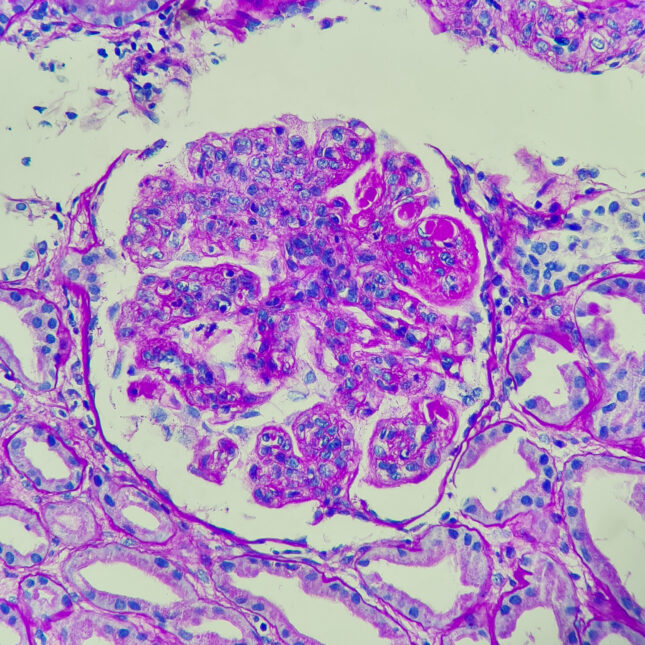
Lupus, in superhero terms, tells a devastating story. A loyal hero turns villain and works to destroy his own people. But new research asks the question: What if immune cells could be turned back into good guys, and actually help save tissue damaged by autoimmune disease?
Lupus is complicated because it wields the body’s own defenses against itself, generating a continuous immune misfire. B cells and T cells are the white blood cells that identify and destroy pathogens in the body. They work together: T cells make a protein called CXCL13 that calls B cells to places of inflammation. In a disease like cancer, more CXCL is good because it brings B cells to the scene of malignancy and amplifies the immune system response. In the case of lupus, B cells are recruited to places they shouldn’t be, like the skin, lungs, and kidneys.
More than 200,000 adults in the U.S. are thought to have the most common form of lupus, systemic lupus erythematosus. Because the immune system attacks healthy tissues, lupus can lead to organ damage and joint pain, as well as fatigue, facial rash, and other symptoms. For decades, scientists have been trying to tease apart the factors that lead to the condition, which most often affects women and girls.
Many lupus patients also have another imbalance, according to the data. Compared to those without autoimmunity, people with lupus have fewer of the T cells that make a protein called interleukin-22, which could help with inflammation and wound healing. It’s a double disadvantage: lower levels of helpful cells, and higher levels of damage-promoting ones, said Jaehyuk Choi, an associate professor of dermatology, biochemistry, and molecular genetics at Northwestern University’s Feinberg School of Medicine.
“We wondered if there was a molecular switch that sort of controlled how these cells can toggle between these two,” said Choi, senior author of the research published Wednesday in Nature. With a team of researchers and fellow senior author Deepak Rao, an associate professor of medicine at Harvard Medical School, Choi found the switch.
Cells are able to convert between the two phenotypes (helpful IL-22-makers, harmful B-helpers) with a “naturally occurring seesaw,” he told STAT. And scientists might be able to tip the plank in the direction of helpful T cells as a way of treating the disease.
Choi and Rao’s study points to the aryl hydrocarbon receptor, or AHR, as a controller of the cellular seesaw, and therefore a cause of lupus.
AHR activates genes that are important for the birth of IL-22-producing T cells (the good guys in this movie). It also helps keep CXCL13 — that protein that calls in lots of B cells — in check. Their research found that suppressing AHR let the population of harmful cells proliferate, while boosting AHR with an agonist increased the presence of wound-healing T cells. (When they studied joint fluid from people with rheumatoid arthritis, they found a similar ordeal happening with CXCL13 and AHR, suggesting the problem could extend beyond lupus and to other autoimmune conditions.)
The investigators performed numerous tests, including using CRISPR to delete AHR and see what happened, running single-cell analysis, RNA sequencing, and studying patients on a lupus therapy. These experiments were “quite extensive” and produced an “enormous amount of data,” said Marta Alarcón-Riquelme, a full professor and scientist at the Centre for Genomics and Oncological Research: Pfizer and the University of Granada in Spain. The end result is a study that unites many of the abnormalities and imbalances that lupus researchers have reported for decades — and offers an idea of the mechanism by which it’s happening, she said. (Alarcón-Riquelme was not involved in the study.)
The study also suggests that interferons, immune system-triggering molecules, are actively promoting the imbalance by antagonizing AHR. This then leads to more inflammation and fewer of the helpful cells. “We have known for many years that patients with lupus have too much interferon production, yet how interferon contributes to disease has been less clear,” Rao said.
Certain lupus drugs, such as anifrolumab (AstraZeneca’s Saphnelo), target the problem by blocking interferon. But addressing AHR itself may make for a more “surgical” approach to treatment, Choi said. For a long time, lupus drugs have broadly suppressed the immune system, which can be effective but also cause unwanted side effects and health risks.
Clearer insights into what causes lupus could help drug developers take a more narrow approach. Rao and Choi’s study “nominates a new strategy” focused on activating AHR.
More research is needed to figure out if IL-22 T cells are truly good and wound-healing for everyone with lupus, and whether this approach could be turned into a viable treatment for lupus or other autoimmune diseases.
STAT’s coverage of chronic health issues is supported by a grant from Bloomberg Philanthropies. Our financial supporters are not involved in any decisions about our journalism.
To submit a correction request, please visit our Contact Us page.











STAT encourages you to share your voice. We welcome your commentary, criticism, and expertise on our subscriber-only platform, STAT+ Connect